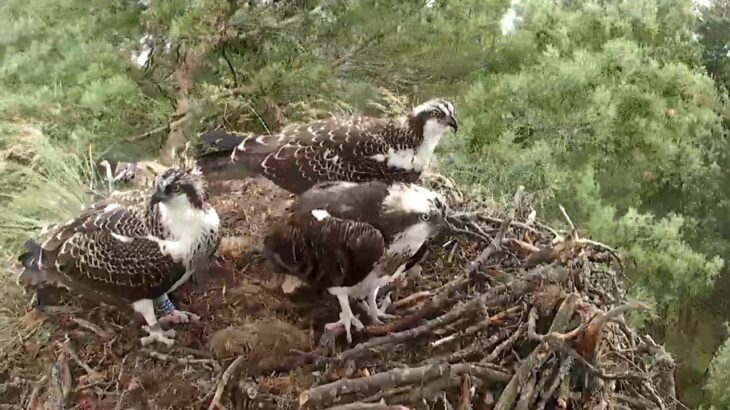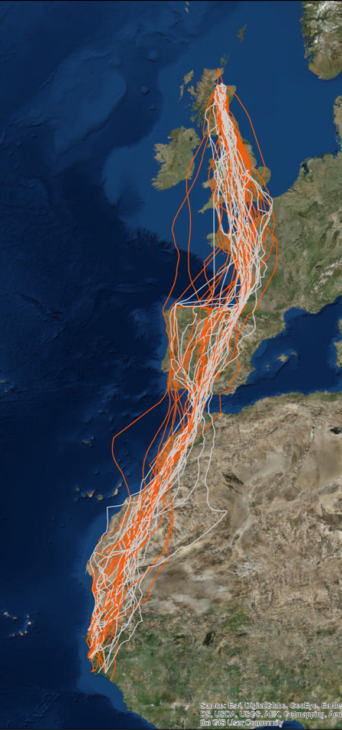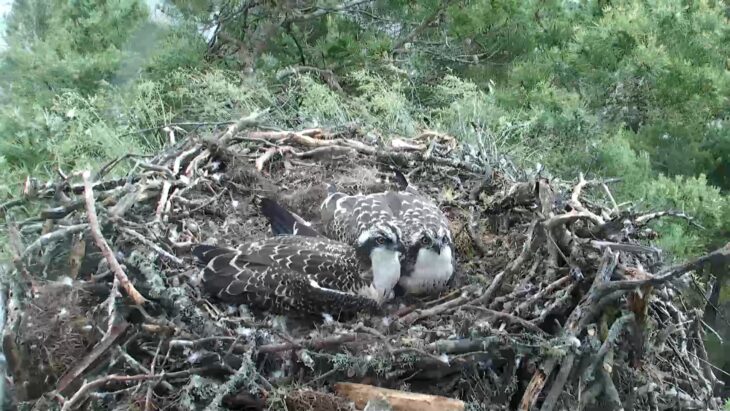How ospreys find their way from Scotland to Africa
The ospreys are off! PT4 and PT5 have now started their first journey to West Africa where they will spend at least the next two years of their life. It could be several years until they returns to Scotland.
Their mother, LF15, departed a couple of weeks ago on her long journey back to West Africa where she will take a much-needed break after the demanding breeding period. Hopefully she’ll be making the return journey back to Lowes in March along with her partner LM12, who started his migration once the young birds had left.
Once in Africa, the ospreys will spend the time relaxing and eating – fish are abundant in West Africa and the birds will spend 90% of the 12 hour day quietly perching. The perfect holiday if you ask me! But before they can start their holiday, they need to endure a long migration – around 6,700 kilometres for Perthshire birds – to their favoured areas, mainly in Gambia, Senegal and Guinea Bissau.
Approximately 50% of ospreys die in their first year
Migration is a dangerous endeavour, especially for juvenile ospreys – approximately 50% of ospreys die in their first year.

Ospreys aren’t the only birds to migrate, there are many species of migratory birds, some which undergo jaw dropping migrations. The bar-tailed godwit for example flies non-stop for 9 days all the way from Alaska to New Zealand! And that’s not even the furthest migration, the arctic tern holds that record, travelling a whopping 90,000 km every year from breeding grounds in the far Northern hemisphere to winter on the Antarctic coast.

How do birds navigate?
Migration over such long and unfamiliar distances requires efficient navigational skills. Birds navigate and orient themselves using their own internal ‘map and compass’ and it is thought that at least one component of this is obtained from the earths geomagnetic field. Detecting the earth’s geomagnetic field requires unique sensory mechanisms, but how these sensory mechanisms work has long remained a mystery.
Magnetite
One theory proposed was the magnetite theory. Magnetite is a type of iron oxide which can interact with Earth’s magnetic field. In birds, cells containing magnetite have been found in their eye and nasal cavities and in their beaks and it is thought that these cells may influence the direction in which the bird flies. Experiments in warblers has shown that cutting the nerve that links the beak to the brain disrupts their orientation.
Cryptochrome
However, more recently the leading theory in how birds navigate is the cryptochrome theory. It is thought that birds can “see” magnetic information due to a protein found in their eye called cryptochrome, specifically cryptochrome 4 (Cry4). Cryptochromes respond to light and are involved in the circadian rhythm (internal clock that reacts to light and and dark) of animals.
Cry4 is found in the retina of birds and the direction of the earth’s magnetic field influences the reaction Cry4 goes through in the presence of light. This provides information for birds to orientate themselves. In support of this theory, it has been discovered that birds can only navigate using their magnetic sense in the presence of light. Also, a study found that the amount of Cry4 expressed in the retinas of European robins was higher during the migratory season compared to the non-migratory season.
Other techniques
Birds don’t just use their magnetic sense to navigate, they also use other senses such as sight and smell. It is thought that birds learn to use landmarks to navigate with increased precision. Tracking ospreys on their migration has shown us that young birds tend to take longer migration routes than the experienced adults. With each migration ospreys learn the most energy efficient routes and, tending to stick to land as much as possible and choosing the shortest crossing points over water. This is because over land they can use thermals to glide whereas flying over water requires a lot more flapping in flight.

Risks on the route
Migration doesn’t always go to plan and there are many records of birds being blown off course. For example one osprey from the north of Scotland, named Stan, was blown far off course and ended up in the Cape Verde Islands.
It is important that ospreys build up strength and consume enough food before heading off on migration in order to to endure the threat of strong easterly winds, exhausting heat and days without food. Many individuals will stop off along the way to break up the journey.
The deadliest section of their journey is the gruelling few days flying over the Sahara desert. This leg of the journey accounts for a large proportion of mortality in ospreys on their first migration. Swedish studies suggest 1 in 3 young ospreys die crossing the Sahara during their first migration. Ospreys also face other man made risks such as getting caught up in fishing nets and fishing tackle, and of course the ever present hazard of plastic pollution.
Many aspects of migration and how these birds navigate so well without any prior experience still remains a mystery.
Despite the incredible amount of scientific research and our growing knowledge of bird migration, many aspects of migration and how these birds navigate so well without any prior experience still remains a mystery.
Many birds, including our juvenile ospreys, PT4 and PT5, are ringed, and reporting sightings of these birds is a great help in gaining a greater understanding of where these birds go during migration. You can report any ringed birds that you seen here.

We wish all of our ospreys luck on their journey to West Africa and look forward to hopefully hearing about the return of PT4 and PT5 in a few years time.
Emily Mason
Assistant Ranger
Help protect Scotland’s wildlife
Our work to save Scotland’s wildlife is made possible thanks to the generosity of our members and supporters.
Join today from just £3 a month to help protect the species you love.
Preface
The ospreys are off! PT4 and PT5 have now started their first journey to West Africa where they will spend at least the next two years of their life. It …
